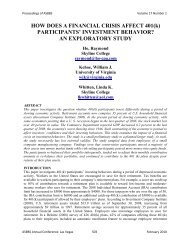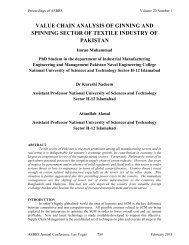stock repurchase announcements: a test of market ... - Asbbs.org
stock repurchase announcements: a test of market ... - Asbbs.org
stock repurchase announcements: a test of market ... - Asbbs.org
Create successful ePaper yourself
Turn your PDF publications into a flip-book with our unique Google optimized e-Paper software.
Walecki<br />
Commerce, 2007a & 2007b). It is not clear what kind <strong>of</strong> concepts and theoretical foundations<br />
have exactly been used in those regional development programs.<br />
The supporters <strong>of</strong> the cluster based development will most likely continue to face serious<br />
challenges in a real life with the application side <strong>of</strong> the theory. Gollub insists that for regional<br />
development to be successful it must move to the second stage, which he calls Clusters 2.0. He<br />
sees the first stage <strong>of</strong> cluster based development strategies as more <strong>of</strong> a ‘wishful thinking’, which<br />
was <strong>of</strong>ten limited to a mere description <strong>of</strong> the existing clusters. Gollub suggests that the second<br />
stage should focus on implementation and it must not only include a better understanding <strong>of</strong> the<br />
overall regional performance, but also a solid assessment <strong>of</strong> other competing regions. He sees all<br />
regional economic actors working together and supporting each other (Gollub, 2004). In that<br />
sense, the Green Valley Initiative may have a potential to advance to that second generation <strong>of</strong><br />
clusters as it seems to satisfy some <strong>of</strong> the above conditions, but a strong leadership and political<br />
will would still be needed to bring all participants together to agree on common regional goals<br />
and necessary actions to implement future recommendations.<br />
If Clusters 2.0 are capable <strong>of</strong> adding a better understanding <strong>of</strong> the region’s geographic space and<br />
its competitive position, then there is perhaps already a need for Clusters 3.0, which would fully<br />
integrate geographic and economic spaces <strong>of</strong> individual regions and also its main economic<br />
actors. Clusters 3.0 would require government agencies and other stakeholders to go beyond<br />
traditional regional interests and invest more in learning about economic spaces <strong>of</strong> all regional<br />
agents, including business firms and other stakeholders. They would need to incorporate current<br />
and future environmental concerns and focus on sustainable development. Clusters 3.0 would<br />
have to consider new trends in location patterns in their geographic territory, as well as within<br />
competing regions, countries and even trade/ economic blocs. A very little progress has been<br />
made so far trying to predict future shifts in comparative and competitive advantages <strong>of</strong> particular<br />
regions and individual firms, which is crucial to regional- as well as business sustainability and<br />
prosperity. More than a quarter century ago Welles suggested that: “the most difficult factor to<br />
weigh is an area’s future, because high-growth areas can change overnight” (Welles, 1981, p.<br />
163). This observation is as true today as ever before, and would have to be taken seriously by all<br />
economic actors.<br />
Finally, regional development faces new challenges today that are <strong>of</strong>ten international in nature. A<br />
rapid progress in both globalization and regionalization demonstrate the need to understand<br />
important changes within geographic and economic spaces. At the international level Fujita<br />
identifies three cores <strong>of</strong> the regional integration as NAFTA, EU, and East Asia (Fujita, 2007b),<br />
rather than one unified global <strong>market</strong>. These powerful regional cores will continue to have<br />
serious implications for business expansion and economic development. Rather than fighting<br />
regionalization and globalization all levels <strong>of</strong> governments need to learn how to adapt better to<br />
those new trends and how to identify new opportunities, as suggested by Peter Drucker over ten<br />
years ago (Drucker, 1997). Unfortunately, the continuous lack <strong>of</strong> sufficient attention to<br />
geographic space is also clearly demonstrated by an enormous economic progress in some<br />
countries and regions and a disturbing increase in poverty in other areas. Governments will have<br />
to move beyond the investigation <strong>of</strong> the existence <strong>of</strong> industry clusters to be able to understand<br />
their economic and geographic environments and to plan for sustainable future development.<br />
CONCLUSIONS<br />
There is sufficient evidence and many empirical studies that clearly show the benefits and even<br />
the necessity <strong>of</strong> including geographic space in business education and management decision<br />
ASBBS E-Journal, Volume 4, No.1, 2008 190

















